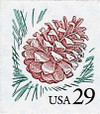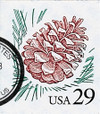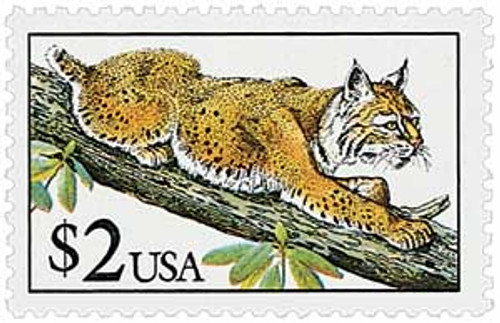
# 2491 - 1993 29c Pinecone
US #2491
1993 Pine Cone
- Part of Flora and Fauna series
- First self-adhesive stamp produced using only engraving
- Produced in booklets of 18 and coils
Stamp Category: Definitive
Set: Flora and Fauna Series
Value: 29¢, First Class mail rate
First Day of Issue: November 5, 1993
First Day City: Kansas City, Missouri
Quantity Issued: 720,000,000
Printed by: Banknote Corporation of America
Printing Method: Photogravure
Format: Panes of 18 from plates of 324, coils from plates of 216
Perforations: Die Cut
Why the stamp was issued: This stamp was issued to cover the First-Class mail rate. It was one of the first self-adhesive definitives of 1993 issued to satisfy customer demand.
About the stamp design: The Pine Cone stamp was designed by Paul Breeden and had been in the USPS files for 10 years. According to the artist, the stamp pictures a pine cone from a Ponderosa pine. This is the most common species of pine found in the US.
Breeden, a National Geographic artist, used a technique known as scratchboard. With this technique, clay-coated paper is covered with ink, then the artist scratches away the areas he doesn’t want colored. When this phase of his painting was completed, he painted pine needles around the pine cone.
About the printing process: The stamp was produced as a pane of 18 that could be folded into a booklet. Collectors could also buy coil strips of 18 stamps. The stamps were placed farther apart than the booklet stamps so the coils could be used by the USPS to apply the Pine cone stamp to First Day Covers.
This was the first self-adhesive stamp to be printed using only intaglio engraving. Previous self-adhesives were produced using engraving and lithograph.
First Day City: The First Day of Issue ceremony took place on opening day of Midaphil 93, a stamp show held in Kansas City, Missouri.
Unusual fact about this stamp: This stamp was sold before its official issue date. The earliest known use was October 18.
About the Flora and Fauna series:
The Flora and Fauna stamps picture plants and animals found in the United States. The definitives were originally called the “Wildlife” series, which replaced the Great Americans series. The first stamp in the series was the $2 Bobcat issued in June 1990. The first time the term “Flora and Fauna” was used for the series was nine years later, when the Red-Headed Woodpecker stamp was used.
The series contained 36 face-different stamps. The flora stamps pictured flowers, berries, fruit, and a pinecone. The fauna stamps mostly depicted birds but also included four-footed animals, a honeybee, and a sunfish. The final stamps in the series were issued in 2001.
History the stamp represents:
Although pine trees can be found in a wide range of environments throughout the world, these tall, stately trees are especially common in the mountains of western and southeastern North America, southern Europe, and southeastern Asia. There are over 100 species of pines. Some grow as tall as 200 feet, while others remain small and shrublike.
Pine trees belong to a group of plants called conifers, which reproduce by means of cones that produce pollen and seeds. There are actually male and female cones, but when people think of "pine cones" they are usually referring to the females that have woody scales and are much larger than males. Fertilized in the spring by the pollen of male cones, the egg cells of females develop into seeds, which usually take several years to mature. In some species the cones open at maturity, while others remain closed until they are opened by food-seeking animals.
Pines are the world's most important source of timber. Because they grow rapidly and form straight, tall trunks, they are ideal for lumber. Some pine trees produce resin, a substance used to make paint, turpentine, and soap. In addition, the wood pulp of many species is used in manufacturing paper.
US #2491
1993 Pine Cone
- Part of Flora and Fauna series
- First self-adhesive stamp produced using only engraving
- Produced in booklets of 18 and coils
Stamp Category: Definitive
Set: Flora and Fauna Series
Value: 29¢, First Class mail rate
First Day of Issue: November 5, 1993
First Day City: Kansas City, Missouri
Quantity Issued: 720,000,000
Printed by: Banknote Corporation of America
Printing Method: Photogravure
Format: Panes of 18 from plates of 324, coils from plates of 216
Perforations: Die Cut
Why the stamp was issued: This stamp was issued to cover the First-Class mail rate. It was one of the first self-adhesive definitives of 1993 issued to satisfy customer demand.
About the stamp design: The Pine Cone stamp was designed by Paul Breeden and had been in the USPS files for 10 years. According to the artist, the stamp pictures a pine cone from a Ponderosa pine. This is the most common species of pine found in the US.
Breeden, a National Geographic artist, used a technique known as scratchboard. With this technique, clay-coated paper is covered with ink, then the artist scratches away the areas he doesn’t want colored. When this phase of his painting was completed, he painted pine needles around the pine cone.
About the printing process: The stamp was produced as a pane of 18 that could be folded into a booklet. Collectors could also buy coil strips of 18 stamps. The stamps were placed farther apart than the booklet stamps so the coils could be used by the USPS to apply the Pine cone stamp to First Day Covers.
This was the first self-adhesive stamp to be printed using only intaglio engraving. Previous self-adhesives were produced using engraving and lithograph.
First Day City: The First Day of Issue ceremony took place on opening day of Midaphil 93, a stamp show held in Kansas City, Missouri.
Unusual fact about this stamp: This stamp was sold before its official issue date. The earliest known use was October 18.
About the Flora and Fauna series:
The Flora and Fauna stamps picture plants and animals found in the United States. The definitives were originally called the “Wildlife” series, which replaced the Great Americans series. The first stamp in the series was the $2 Bobcat issued in June 1990. The first time the term “Flora and Fauna” was used for the series was nine years later, when the Red-Headed Woodpecker stamp was used.
The series contained 36 face-different stamps. The flora stamps pictured flowers, berries, fruit, and a pinecone. The fauna stamps mostly depicted birds but also included four-footed animals, a honeybee, and a sunfish. The final stamps in the series were issued in 2001.
History the stamp represents:
Although pine trees can be found in a wide range of environments throughout the world, these tall, stately trees are especially common in the mountains of western and southeastern North America, southern Europe, and southeastern Asia. There are over 100 species of pines. Some grow as tall as 200 feet, while others remain small and shrublike.
Pine trees belong to a group of plants called conifers, which reproduce by means of cones that produce pollen and seeds. There are actually male and female cones, but when people think of "pine cones" they are usually referring to the females that have woody scales and are much larger than males. Fertilized in the spring by the pollen of male cones, the egg cells of females develop into seeds, which usually take several years to mature. In some species the cones open at maturity, while others remain closed until they are opened by food-seeking animals.
Pines are the world's most important source of timber. Because they grow rapidly and form straight, tall trunks, they are ideal for lumber. Some pine trees produce resin, a substance used to make paint, turpentine, and soap. In addition, the wood pulp of many species is used in manufacturing paper.




















